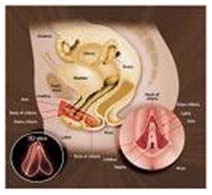Overview
Clitoropexy / Clitoral Hood Reduction
Women's are bothered by enlarged size of the clitoral hood & clitoris head (glans). Hood may protrude causing the woman to be irritated. Prognathous hood and clitoris causes heave in her clothing or appearance of a small penis.
Desired woman's routinely reduce sides of clitoral hood by performing labiaplasty. However, It does not change the projection or length of the clitoral hood. Horizontal incision on the lower clitoral hood & setback the clitoris slightly higher with a some stitches (clitoropexy), is a solution to resolve the problem. The draw up and moving in of head of the clitoris dislodge the suspension and now allows to remove some of the longitudinal hood skin. The hood becomes smaller, and it no longer protrude. There is no risk for nerve injuries or sensation changes.
What Does The Surgery Involve?
It is actually similar to circumcision of the male penis. Like the penis the clitoris has a hood that can prevent required sensitivity in sexual intercourse. This operation is extremely delicate and the gynaecologist performing it is an expert with a great deal of experience. This is necessary because the clitoris has more nerve endings in it than in all the tissues surrounding it. The hood is either partially removed or split to allow the clitoris freedom to enlarge when you feel aroused. The procedure may be done with a laser.

TYPES OF CLITORAL SURGERY
There are three main groups of plastic clitoral procedures : --
Clitorectomy or Clitoral Amputation : - This operation simply removes all that can be seen of the clitoris (ie all of the glans clitoris), and usually involves dissection and partial removal of the corpora. Often the prepuce and clitoral hood will also be removed or used for reconstruction elsewhere. It is believed this procedure is now rarely done in the UK although no data are available.
-
Clitoral Recession : - In this procedure, none of the clitoral structures are removed, instead the clitoral structures are dissected out and then folded up and moved in their entirety, backwards under the symphysis pubis. As in the clitoral reduction procedure, the bilateral dorsal clitoral nerves maintain their connection to the clitoral glans. This procedure was found to cause pain on clitoral engorgement and again it is presumed this procedure is no longer performed.
-
Clitoral Reduction : - In this procedure the glans clitoris is preserved, and the corpora are dissected and partially or totally removed. Most procedures today will identify the two dorsal clitoral nerves and maintain their connection to the clitoral glans. Sometimes the clitoral glans will be reduced in size by wedge excisions, either laterally, ventrally or dorsally.
Aims And Benefits Of Surgery
There are no long term data to support this although there is a widely held belief that feminising genital surgery is "successful" both cosmetically and functionally. It is however impossible to predict the true gender identity or sexual preferences of any baby without an Intersex condition and even more difficult with Intersex children. It is most likely that gender identity has a multifactorial basis including anatomical, genetic and endocrine factors. The contribution of genital appearance to gender identity is unknown but men diagnosed with micropenis in infancy can remain happy with a male gender identity and have a male sexual.
Will There Be Complications?
The most serious complication may be infection. Excessive bleeding tends to occur when in ethnic cultures a non-medical person carries out this procedure. Because you will be attended to by a fully qualified and highly experienced surgeon, you should not experience any complications at all.
How Long Does The Surgery Take?
It takes approximately 1 hour, though it can be slightly less.
Recovery
You may find sitting for long periods painful and this includes driving (which should be avoided temporarily). Strenuous exercise has to be temporarily suspended until swelling is reduced and healing is complete. It may be unwise for you to carry heavy items for a number of weeks to avoid straining the area.
What Can I Expect From The Surgery?
Good news! You should expect a rejuvenated sex life. Un-hooding your clitoris leads to increased stimulation and a noticeable increase in orgasms.
For more information, medical assessment and medical quote
as email attachment to
Email : - info@wecareindia.com
Contact Center Tel. (+91) 9029304141 (10 am. To 8 pm. IST)
(Only for international patients seeking treatment in India)










